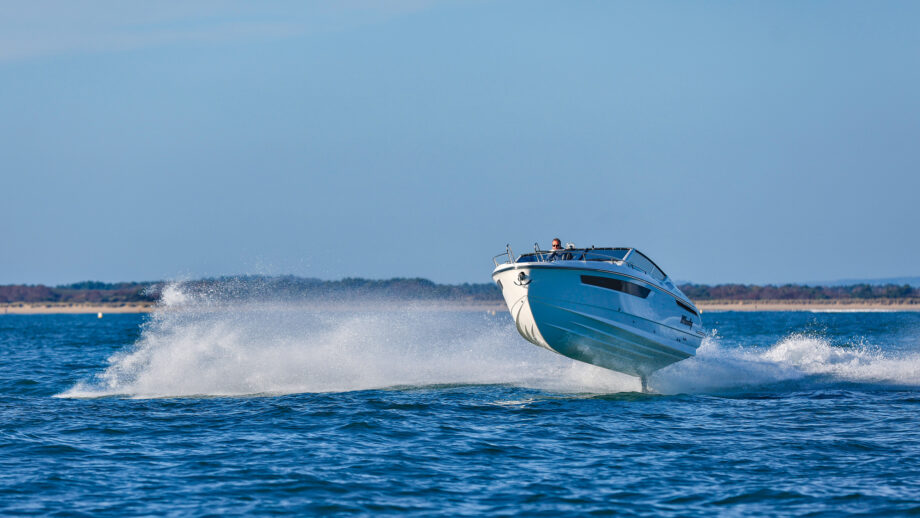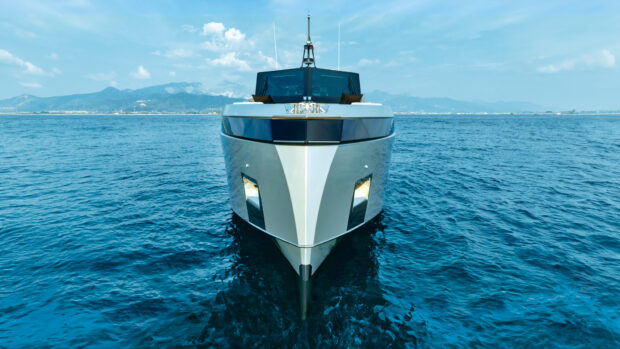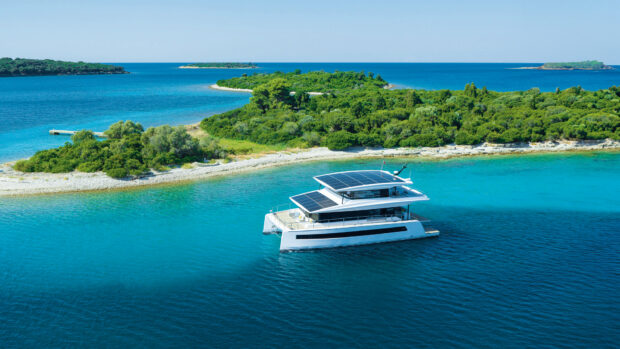Windy’s latest sportsboat, the Windy 29 Huracán may be a little pricier than the competition but delivers the fun while displaying an additional talent for cruising
Let’s not beat about the bush – there’s a big choice of 28-30ft sportsboats in the market at the moment and most of them are less expensive than Windy’s latest offering, the Windy 29 Huracán. Then again Windy has never sought to compete on price. Its USPs are good looks, strong performance, exceptional handling and lasting build quality.
We’ll see how it fares on all those fronts but there’s another reason to consider a Windy 29 Huracán – cruising ability. Nearly all its rivals are powered by petrol outboard motors and prioritise day trips. The Huracán, by contrast, is a compact but very capable cruiser with the option of diesel inboard power – either a 370hp Yanmar 8LV or 440hp Volvo Penta D6.
Both of these deliver similar performance to a petrol outboard while burning significantly less fuel and giving you access to cheaper, more widely available diesel. So how well does it work in practice? We borrowed a Windy 29 Huracán equipped with a 440hp Volvo Penta D6 to find out.

Big diesel engine and a very capable hull deliver plenty of fun and cruising ability. Photo: Paul Wyeth
Devil in the Details
The first thing to note is that the Windy 29 Huracán is a bigger boat than the 29 Coho it replaces. It may only be a few inches longer and wider but the Huracán’s snub nose and taller freeboard create significant extra interior volume. That translates to a deeper, more sociable cockpit and a slightly bigger, taller cabin and heads compartment.
It’s also a very stylish boat. The exterior is the work of Norwegian superyacht designer Espen Øino, while the interior is by British team Design Unlimited. The result looks and feels like a very classy product. Some of that is down to the fresh design language but much of it comes from the thoughtful detailing and premium materials used. This runs right through the boat and encompasses everything from the fixtures and fittings to the quality of the mouldings.
Article continues below…

Cormate Chase 35 first look: A quality offshore performance boat

Axopar 29 sea trial: Sun Top vs Cross Cabin – which is best?
You’ll need to watch our video review to see what we mean but even though the Windy 29 Huracán is built in Poland rather than Windy’s Swedish factory, they clearly haven’t skimped on the specifications. The stainless steel grabrails around the aft sunbed, for instance, are oval rather than round, the locker mouldings are as smooth on the inside as they are on the outside and their hinges and latches are smarter and more robust than is usual for this size of boat.
These may sound like minor details but the cumulative effect makes a huge difference, not just to the enjoyment of the boat but the practicality of it too. There are lockers everywhere, including one for the fenders under the cockpit sole, and the entire aft bench moulding lifts up on an electric ram giving exceptional access to the engine bay.

ABOVE: The removable cockpit table has its own storage rack on the underside of the heavily insulated engine bay lid. Photo: Paul Wyeth
This also reveals a pre-rigged bimini cover that folds up in seconds and tensions at the press of a button, as well as a dedicated storage slot on the underside of the lid for the teak cockpit table and leg. And you only have to look at the thickness of the sound insulation to grasp how seriously Windy takes refinement.
Cockpit and Cabin
The layout of the cockpit also works very well with generous L-shaped seating to starboard, a cosy corner seat to port and a sliding backrest on the aft bench. This allows you to vary the ratio and orientation of the seating/sunbed so it faces forwards, backwards or a bit of both – the latter being particularly handy as an aft-facing seat for a watersports spotter.

Sociable cockpit layout includes multiple lockers under the seats and decking. Photo: Paul Wyeth
The matching bucket seats for the helm and co-pilot adjust for reach and swivel to face inwards. They also bolster for driving while standing, although you lose the hip support that sitting provides. The ergonomics of the helm are close to perfect with good protection from wind blast and an ideal relationship between seat, throttle and helm. We also love the extra grabrail running around the inside of the windscreen.
Our only criticism is that when sitting on the bolstered seat, the top of the windscreen frame is right in your eyeline, and we would prefer to have some analogue dials or a second screen so you could keep an eye on speed, revs, fuel and engine temperatures without sacrificing space on the standard 9in plotter (larger options are available). Twin wipers, washers and a demister are another demonstration of thoughtful detailing.

Basic galley has a sink and a single ring cooking hob. Photo: Paul Wyeth
The steps up to the opening windscreen are deep, well spaced and teak-lined for grip while the windscreen hinges are suitably sturdy and damped by a thick rubber stopper. The low bowrails do leave you feeling a little exposed up here but at least the deck is flat and moulded with a non-slip finish.
Heading below reveals a tiny galley at the foot of the companionway, the only place where there’s enough headroom to stand, with a single diesel Wallas hob, a small sink and just enough storage for a few plates, glasses and pans. The only fridge is a chilled locker under the cockpit floor by the co-pilot’s seat.

Open plan layout is fine for a long weekend away as a couple. Photo: Paul Wyeth
The rest of the cabin is almost entirely filled by the double bed which tapers towards the bow but has enough headroom to sit at the aft end. It’s fine for a night or two and benefits from a good run of eye-level lockers and plenty of natural light from the hull windows and overhead hatch. The big win is a separate heads compartment with a toilet, sink and opening porthole but it’s sitting room only and the shower is on the bathing platform.
The option of diesel power isn’t the only benefit of an inboard design, it also keeps the centre of gravity low and brings Volvo’s grippy DPi sterndrive into play. The big six-cylinder engine is an equally strong but docile companion, which while not quite as quiet as the best petrol outboards, is still remarkably refined by diesel standards.

With no analogue gauges we’d opt for a larger MFD with more space for engine data and a navigation chart. Photo: Paul Wyeth
The electronic throttle keeps gearshifts silky smooth and there’s a trolling button to slip the clutch at idle for slow speed docking manoeuvres. Put the hammer down and it takes a couple of seconds for the engine to really get going but once the turbo kicks in there’s no stopping it. There’s so much torque that you can pick any cruising speed from 20-40 knots without it feeling remotely strained.
Flat-out we saw 43 knots and even at this speed it burns less than two litres per mile, but drop the pace to 30 knots and fuel consumption falls to 1.4 litres per nautical mile. This is around 25% more fuel efficient than an Axopar 29 with a 400hp Mercury Verado and gives the Huracán a range of 230nm with 20% still in reserve, around 50nm more than said Axopar.

Fast, Fun and Refined. Photo: Paul Wyeth
It’s also a very strong and capable hull. We took it out in some sizable seas and it never felt out of its comfort zone, even when the props lifted clear of the water. Inevitably the landings were a little firmer than on the larger 34 Alizé but never enough to elicit any complaint from the hull or helmsman.
In calmer waters it was a joy to helm with a relaxed long-legged gait, perfectly weighted steering and impeccable cornering manners. If anything the steering responses could be sharper and the turning circle tighter as we suspect Volvo has designed it to suit less capable hulls than this.

In calmer waters it was a joy to helm with a relaxed, long-legged gait.
Photo: Paul Wyeth
Windy 29 Huracán specifications
LOA: 29ft 3in (8.91m)
BEAM: 8ft 10in (2.70m)
DRAFT: 3ft 3in (1.0m)
DISPLACEMENT: 3,400kg
FUEL CAPACITY: 400 litres
WATER CAPACITY: 115 litres
ENGINE: 1 x Volvo Penta 430hp V8 petrol, 440hp D6 or Yanmar 370hp diesel
RCD CATEGORY: B
PRICE FROM: £215,168 ex VAT
CONTACT: windyboats.com
 If you enjoyed this….
If you enjoyed this….
Motor Boat & Yachting is the world’s leading magazine for Motoryacht enthusiasts. Every month we have inspirational adventures and practical features to help you realise your sailing dreams, as well as tests and news of all the latest motorboats.
Plus you’ll get our quarterly Custom Yachting supplement where we share the last on offer in the superyacht world and at the luxury end of the market.
Build your knowledge with a subscription delivered to your door. See our latest offers and save at least 30% off the cover price.
Verdict
It’s clear that the Huracán is a fast, fun, capable boat. The real question is whether it’s worth the premium cost? Prices start at £215,168 ex VAT for the 430hp petrol model, while our test boat with the 440hp D6 and all the key options comes to £286,000 inc VAT. That’s a lot for a 29ft sportsboat but thanks to its premium fit out and build quality as well as its superior cruising range, fuel efficiency and comfort, it can justify it. Throw in Windy’s traditionally strong residual values and the argument looks settled. If you can afford the outlay, you will reap the reward for years to come.



 If you enjoyed this….
If you enjoyed this….





